| Here is how we think it all happened (From R. U. Buehler, http://www.hgb-leipzig.de/weltbilder/) Key points: Grand Unified Theories; Horizon Problem; Flatness Problem; Inflation; assembly of hydrogen and helium atoms; matter vs. antimatter |
 |
| Here is how we think it all happened (From R. U. Buehler, http://www.hgb-leipzig.de/weltbilder/) Key points: Grand Unified Theories; Horizon Problem; Flatness Problem; Inflation; assembly of hydrogen and helium atoms; matter vs. antimatter |
 |
We need to take things one "era" at a time.
Big Bang (Cosmic timeline from M. Norman, http://archive.ncsa.uiuc.edu/Cyberia/Cosmos/CosmicMysteryTour.html)

Planck Era
| Conditions were so extreme in the Planck Era that our current understanding of physics is inadequate to tell us much about them. | "The Universe is not only queerer then we suppose, it is queerer
than we can suppose." -Mark Twain |
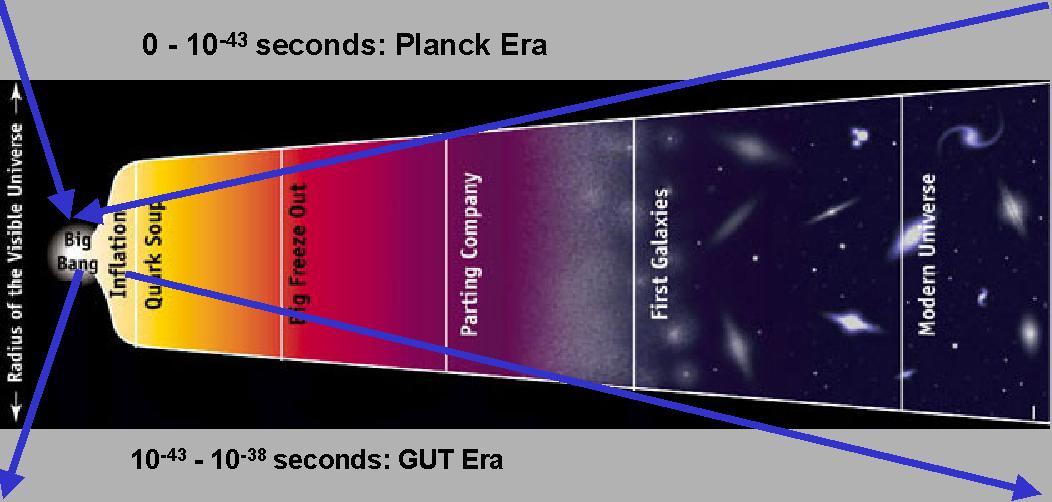
Under conditions of extreme temperature and density, the four fundamental forces of physics look more and more like different manifestations of a single force law.
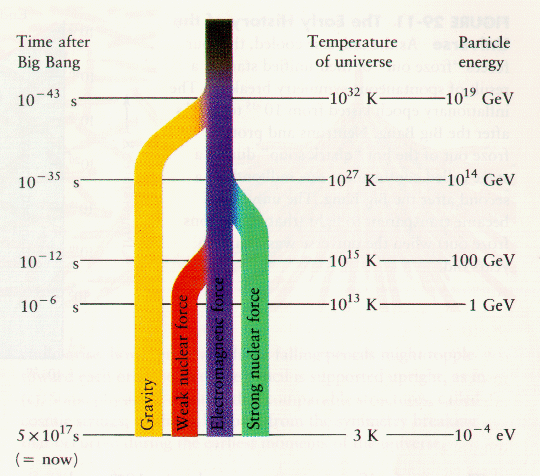 |
Physicists have successfully
developed a theory that unifies the strong, weak, and electromagnetic forces, called (with a little puffery) the Grand Unified
Theory. The three forces would have been
unified under the conditions in the first 10-38 seconds or so.
Physicists assume that gravity can be unified under the extreme conditions in the first 10-40
seconds, but so far this has not been demonstrated. (From http://zebu.uoregon.edu/~imamura/123/lecture-9/lecture-9.html)
|
about 1035 times in 10-32 seconds, from less than the size of a single electron to the size of a golf ball.
A simple expanding universe has two difficult problems to solve, both of which are neatly accounted for by this rapid inflation.
The Horizon Problem
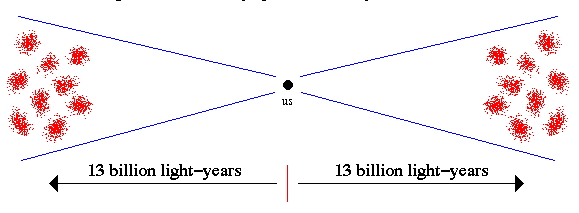 |
How can the Universe be so uniform? Now, it would take billions of light years for a change to be communicated across a significant part of the Universe. (From J. Schombert, http://zebu.uoregon.edu/~js/ast123/lectures/lec19.html) |
 |
If the Universe just expanded in a uniform way,
it would have developed large uniformities over distances where the light communication
time would be too long to even them out. The observed high degree of uniformity (to about
1 part in 100,000 for the 3K radiation!) must have been locked in at an early stage and maintained since then. We illustrate the problem with a band
that synchronizes on the beat of a drum on the left side in this animation. By the time
the sound reaches the right side, the band is half a second behind over there compared
with where it started on the left side - we have a nonuniformity of the band playing for
half a second on the left side before it knows it should be playing on the right side. Similarly, indications of an event at one place in the early Universe - say an explosion that heated up its surroundings tremendously - would travel outwards from it at the speed of light. Therefore, there would be a delay in the rest of the Universe responding - for example, heating up due to the energy it released. Since the early Universe was a very dynamic place, it would be expected to be heated very non-uniformly - not the very smooth, uniform place we know it was!! (animation by G. Rieke) |
The high degree of uniformity was established in the first 10-35 seconds and then locked in by the abrupt expansion that made it impossible for large scale interactions to upset it!
 |
To see how this would work, go back to the marching band we discussed just above. Suppose the band started out very small and got the "beat" from the drummer, and then expanded much faster than the speed of sound, before anyone could get out of synchronization. Then when it began to play, both the left and right sides would be playing together. This is exactly the idea behind inflation in the early Universe, strange as it seems. Everything gets evened out when the Universe is very tiny and then the Universe expands extremely rapidly and becomes 1035 times bigger but retains the uniformity from when it was tiny. (animation by G. Rieke) |
Having the Universe come out just at the critical density is a lot like balancing a pencil on its tip -- it can be done only with the greatest delicacy.
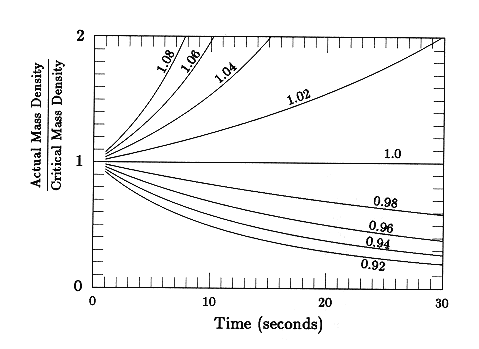 |
This figure shows that the Universe has to be exactly at the critical density (the curve labeled 1.0) at the first second of its evolution, or it rapidly departs from that condition toward being strongly open or closed. The other curves are labeled with the density compared with the critical value at the first second, and they evolve quickly to values differing by huge amounts from critical. (From J. Schombert, http://zebu.uoregon.edu/~js/ast123/lectures/lec19.html) |
 |
No matter what you start with, if
something is expanded by such a big (1035) factor, it will look very flat
anyplace you look. Thus, inflation also explains how the
Universe came out exactly at An ant crawling on a balloon experiences a curved surface. See how the ant's Universe is flattened by blowing up the balloon! (From J. Brau, http://blueox.uoregon.edu/~jimbrau/astr123/Notes/Exam3rev.html.) |
The use of an analogy with simple geometry to explain something so fundamental as the Universe being at the critical density may seem overly simplistic. However, the relation between the curvature of space and its contents is very fundamental in the Einstein-Lemaitre-Friedmann version of the Universe. Thus, the concept of inflation solves both the Horizon Problem and the Flatness Problem.
GUT Era
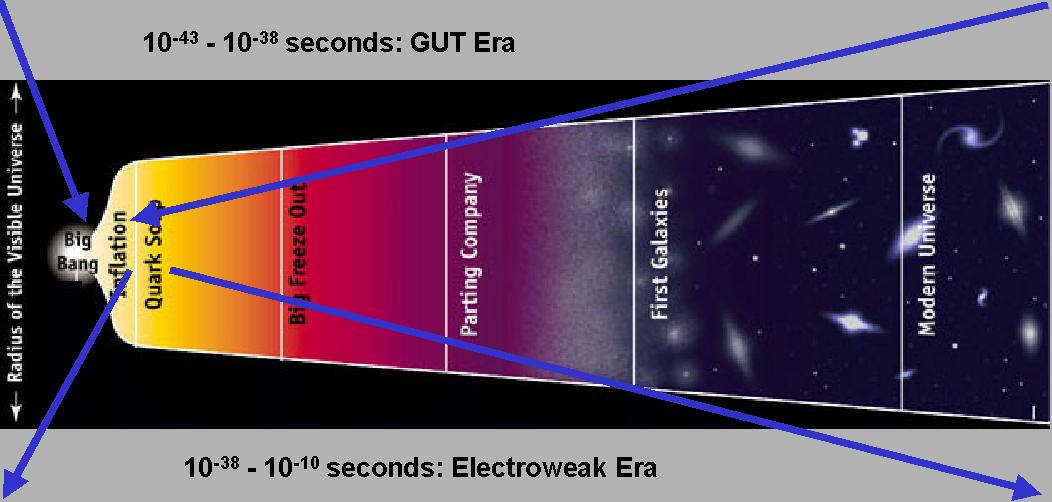
Electroweak Era
After the inflationary epoch, the steady expansion that Hubble discovered began. At about 10-10 seconds, the electroweak force separated into the electromagnetic and weak forces, bringing the Electroweak Era to an end and establishing a Universe governed by the physical laws as we now experience them.
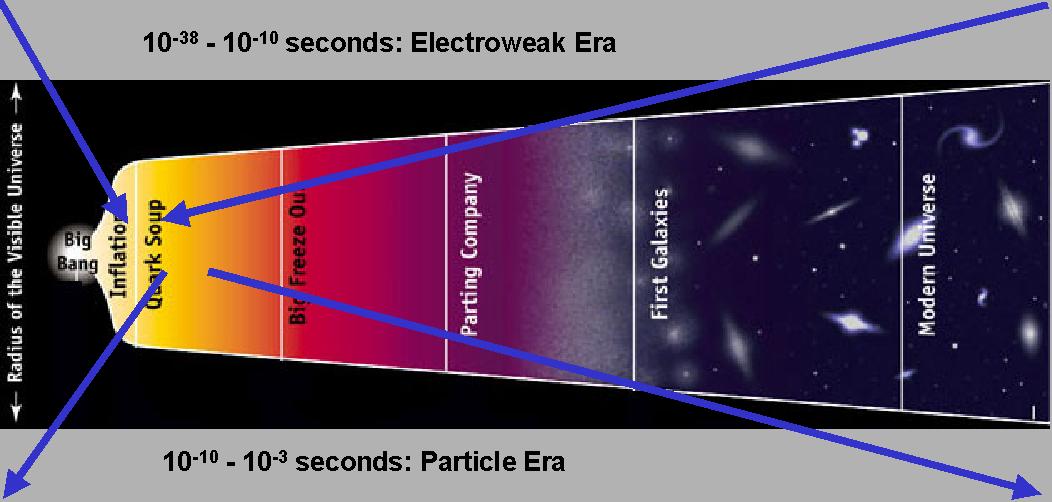
At first, it
was too hot for protons and neutrons to survive. Instead, there was a dense sea of
"quarks" and "anti-quarks", the underlying particles out of which
protons and neutrons (and their anti-particles) are made. There was a nearly equal mixture of quarks and
anti-quarks -- anti particles in physics behave exactly as their counterpart particles but
have opposite charge and annihilate if they collide with particles, so the mass of both
the particle and anti-particle is converted to energy and emerges as gamma rays. As the Universe expanded and cooled, annihilation proceeded; either
because of a slight asymmetry in the behavior of the particles or a slight excess of
particles over antiparticles to start with, all the anti-quarks were annihilated and only
quarks were left ![]() -- along with a lot of gamma rays.
-- along with a lot of gamma rays.
 |
As the Universe cooled further, the quarks
slowed down until the strong nuclear force could draw them together to make protons and
neutrons (at about 1 second after the Big Bang). See: Cosmos in a Computer, U. Illinois http://www.ncsa.uiuc.edu/Cyberia/Cosmos/CosmosCompHome.html |
Particle Era

The temperature remained high enough for the first 10 seconds that energy was still passed back and forth freely between electrons/antielectrons (the latter called positrons) and photons. (figures from J. Schombert, http://zebu.uoregon.edu/~js/ast123/lectures/lec18.html)
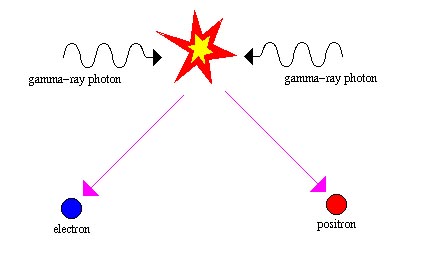 |
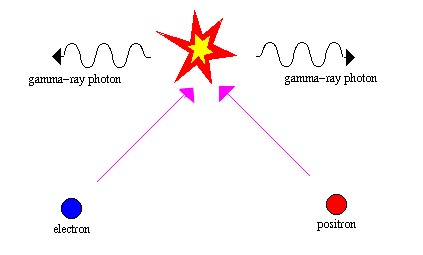 |
A summary of how it works is below. Take a close look, since we will come back to it when we talk about the sun.
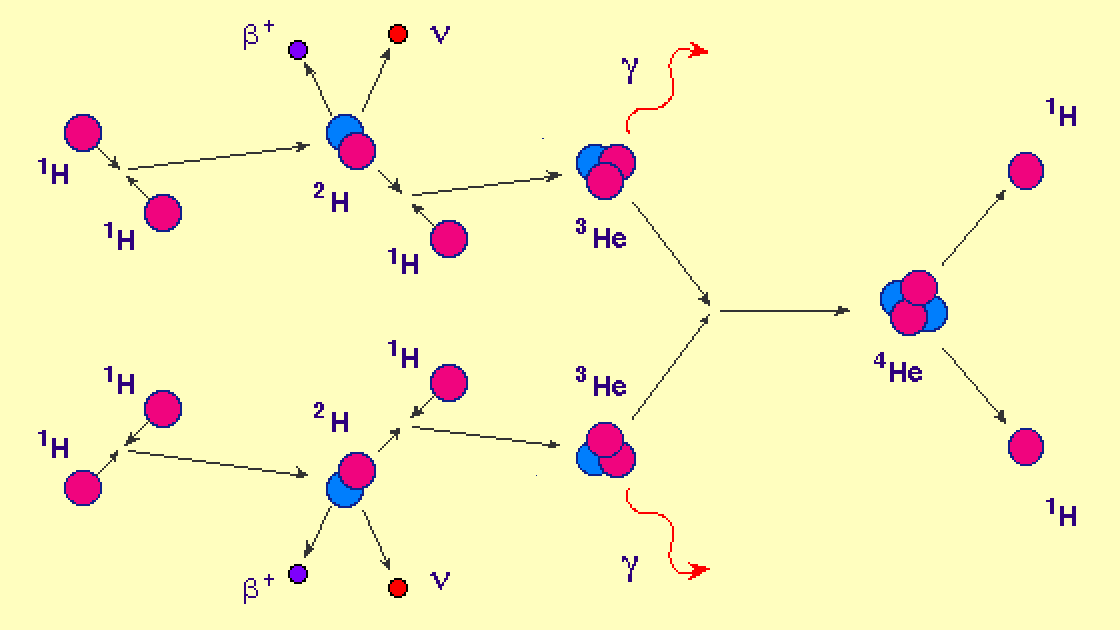 |
(From U. Tenn Ast 162, http://csep10.phys.utk.edu/astr162/lect/energy/ppchain.html) |
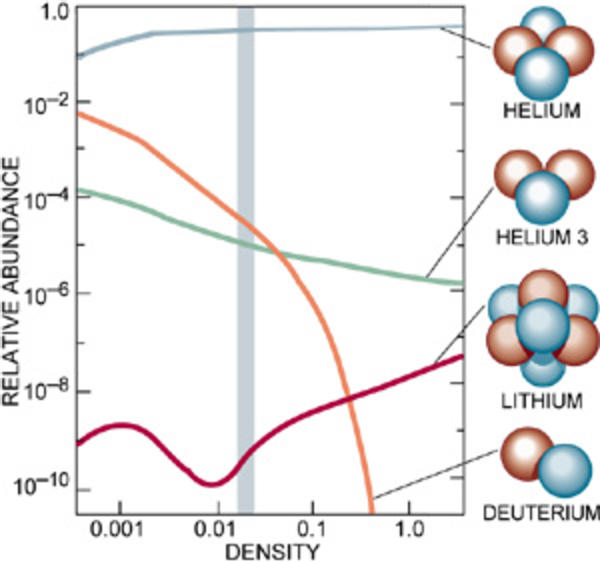 |
Models of "different" Universes show that the reactions proceed farther the greater the amount of protons and neutrons to interact. Thus, with imaginary universes of increasing density, we get increasing amounts of helium 4 and lithium, but decreasing amounts of helium 3 and hydrogen 2 (deuterium). (From M. White, http://astron.berkeley.edu/~mwhite/darkmatter/bbn.html) |
From the current-day abundances of deuterium and lithium, our Universe must have had a relatively low density of protons and neutrons to start with -- about 6% of the total. That is, the density of the Universe was not high enough to sustain the reactions building more complex elements than lithium, and only a small amount of lithium was built compared with the possibilities for a denser Universe. These particles are called altogether "baryons". The remaining 94% of the mass is in the dark matter, which does not appear to be normal baryons.
Test your understanding before going on![]()

In Hindu mythology, the dance of Shiva Nataraja expresses the birth and death, and rebirth of the Universe. from http://webonautics.com/mythology/shiva5.html |

The Boomerang experiment launch is shown under the map obtained of the sky. http://www.nsf.gov/od/lpa/news/02/fsballoon.htm |
|
Click to return to syllabus |
||
| Click to return to The Fate of the Universe | hypertext |
Click to go to Electroweak and Particle Eras |